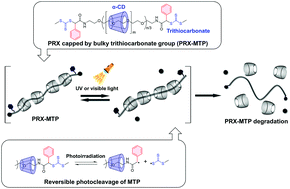Visible light-degradable supramolecular gels comprising cross-linked polyrotaxanes capped with trithiocarbonate groups†
Abstract
Visible light-degradable supramolecular gels were designed using polyrotaxanes (PRXs) containing bulky trithiocarbonate groups as stopper molecules that are cleaved by visible light irradiation. Visible-light-degradable PRXs comprise poly(ethylene glycol) (PEG) threaded through multiple α-cyclodextrins, where both terminals of the PEG axis were capped with bulky trithiocarbonate groups. The synthesized PRXs did not degrade in the dark. Irradiation with ultraviolet (UV; 365 nm, 7.03 mW cm−2) and visible light (465 nm, 44.5 mW cm−2) induced cleavage of the trithiocarbonate groups, and the α-cyclodextrins were dethreaded from the axial chain, demonstrating the photodegradability of PRXs capped with trithiocarbonate groups. Visible light-degradable supramolecular gels were prepared by cross-linking PRXs with hexamethylene diisocyanate. The supramolecular gels were degraded and disappeared upon irradiation with both UV and visible light due to photodegradation of PRXs. Visible light degradable supramolecular gels are considered to be a new type of photodegradable material that can circumvent the potential phototoxicity of UV light to be applicable for alternative photodegradable biomaterials.



 Please wait while we load your content...
Please wait while we load your content...